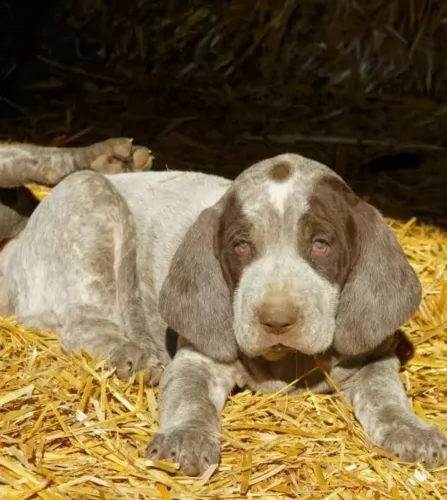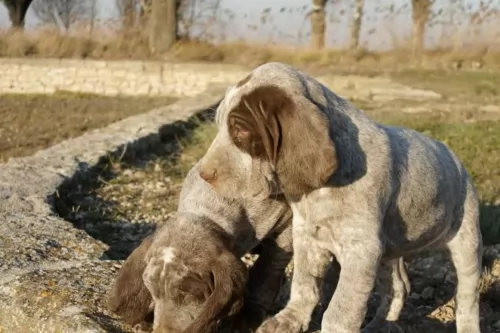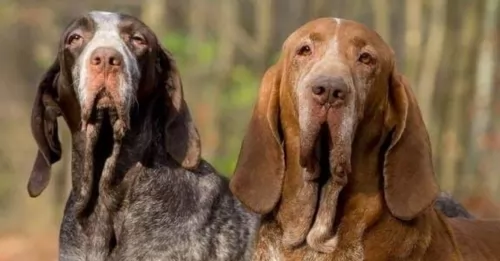 MyDogBreeds
MyDogBreeds Perdiguero de Burgos is originated from Spain but German Coolie is originated from Australia. Both Perdiguero de Burgos and German Coolie are having almost same height. Perdiguero de Burgos may weigh 8 kg / 18 pounds more than German Coolie. Perdiguero de Burgos may live 4 years less than German Coolie. Perdiguero de Burgos may have more litter size than German Coolie. Both Perdiguero de Burgos and German Coolie requires Low maintenance.
Perdiguero de Burgos is originated from Spain but German Coolie is originated from Australia. Both Perdiguero de Burgos and German Coolie are having almost same height. Perdiguero de Burgos may weigh 8 kg / 18 pounds more than German Coolie. Perdiguero de Burgos may live 4 years less than German Coolie. Perdiguero de Burgos may have more litter size than German Coolie. Both Perdiguero de Burgos and German Coolie requires Low maintenance.
 The Iberian Peninsula is thought to be the place of origin for many of the pointing breeds of Europe, and the Perdiguero de Burgos hails from Spain. Known as the Spanish Pointer, the dog has contributed to the development of other pointer breeds.
The Iberian Peninsula is thought to be the place of origin for many of the pointing breeds of Europe, and the Perdiguero de Burgos hails from Spain. Known as the Spanish Pointer, the dog has contributed to the development of other pointer breeds.
The dog has been around since the 1500s and believed to be a descendent of the Perdiguero Navarro and the Sabueso Español.
Today's Perdiguero de Burgos is smaller and lighter so as to make it into a better bird-hunting dog.
The Perdiguero de Burgos has always been used to hunt deer but today it is used as a pointer of smaller animals and birds.
 The German Coolie is misnamed as it is an Australian bred dog and often called the Australian Koolie or Coolie. This Australian breed is more often just called a Coolie. The breed is a typical herding breed and a working dog that needs a job all the time. They have been a favorite of Australians since the late 1800’s when local dogs were bred with British working dogs.
The German Coolie is misnamed as it is an Australian bred dog and often called the Australian Koolie or Coolie. This Australian breed is more often just called a Coolie. The breed is a typical herding breed and a working dog that needs a job all the time. They have been a favorite of Australians since the late 1800’s when local dogs were bred with British working dogs.
Although all Coolie’s are not the same. Within the breed there is a lot of variation. This is because the Coolie was bred individually for different regions in Australia. In a very different writing the Koolie Club of Australia does not define the Coolie breed on confirmation as all other purebred dogs are defined. Instead the Coolie is defined by ability to work. In light of this most Coolie breeders state that the Coolie is a breed and the variations you see among regions are types within the breed.
As a herding dog, the Coolie brought a lot of skill to the Australian farmers and sheep herders. The Coolie will round up the sheep and bring them back to their enclosure at the shepherd’s command. They are upright, silent, working dogs. Not only do they herd sheep they are important at sheering to “cut out” the sheep or assist in the close quarters of lambing.
In Queensland North and New South Wales, the Coolie is medium boned, tall and agile ready to herd cattle over a long stretch of miles. In the Snowy Mountains of New South Wales and the Hunter Valley Region, the Coolie is shorter and thicker in order to be able to get cattle that are lying low out from the gullies and dense bush. The Coolies found in Victoria are the smallest of all.
No matter where they live and work, the Coolie is bred to help the workers there, the farmers, the stockman, and the grazier. All Coolies are adaptable and very agile. They all have a strong willfulness to accomplish what they are asked to do. The ancestors of these various Coolie was the British Collie – a smooth coated, blue merle. This Collie was crossed with the Black and Tan Collie from the Scottish Highlands. It is believed that these are the same Collie breeds that came to Australia to create the Heeler.
The name may come from the German immigrants working in South Australia and unable to pronounce Collie incorrectly they called the dogs German Coolies. There is also a fraction of German breeders who believe that the German Tiger dog was brought to Australia in the 18th century and then when the Collies came they were bred together. Many Coolie breeders have records showing that the breed has been in Australia for at least 160 years. It is also believed that the Border Collie and Kelpie (Blue Heeler) were mixed into the breed at sometime as well.
No bench standard exists for the German Coolie even though there is the Koolie Club of Australia. The mission of the club is to protect, preserve and promote the breed. The Australian Sporting Register was recognizing the Coolies in 2004. They are eligible to participate in the Australian National Kennel Council sanctioned sporting trials. They participate in Queensland, New South Wales and Victoria through the individual states sporting register. Here they participate in herding, jumping, obedience, agility and tracking.
Several other recognitions as a herding breed soon followed. The Australian Shepherd Club of America, the American Herding Breed Association, were followed by recognition from others as well. They are not recognized by the American Kennel Club (AKC).
 The Perdiguero de Burgos is a large dog with straight, strong legs and a strong, musculr body. He stands at between 52 - 64 cm and weighs between 22 - 32 kg.
The Perdiguero de Burgos is a large dog with straight, strong legs and a strong, musculr body. He stands at between 52 - 64 cm and weighs between 22 - 32 kg.
The short, smooth coat is white and liver and the coat is heavily flecked or speckled. The ears are Long and floppy, the nose dark brown, the eyes dark hazel and the tail long and fairly slender. The tail has always generally been docked.
The chest is deep, it has a strong, square shaped head with the muzzle being long and quite broad. This dog isn’t recommended for life in the city as they are active dogs requiring a lot of open spaces.
These are wonderfully calm dogs, being gentle and intelligent and with a quite, confident expression to them. Even on the hunt these gun dogs are calm and steady. He is obedient and intelligent, easy to train and patient with children and other dogs.
Training and socialization of this excellent dog simply makes him even more obedient, amicable, Loving and loyal, making him a splendid pet.
 With their strong ancestry among the family of collies and herders, the German Coolie shares the look of collies and shepherds. Even though they differ from region to region and there is no actual standard, they are medium sized dogs with blue or brown eyes or even one of each. The ears are folded over on top when relaxed but they are rigid and straight when he is more alert. The nose is either chocolate or red depending on the color of their coat.
With their strong ancestry among the family of collies and herders, the German Coolie shares the look of collies and shepherds. Even though they differ from region to region and there is no actual standard, they are medium sized dogs with blue or brown eyes or even one of each. The ears are folded over on top when relaxed but they are rigid and straight when he is more alert. The nose is either chocolate or red depending on the color of their coat.
They can have either a long, medium or short coat but most owners want the short coat that is smooth as well. The coat can be one color – red/chocolate or black; Bi – red/white or black/white; Tri – solid black or red with white and brown; Tri merle -merle with white and brown; Merle – red merles and blue merles. Regardless of color, the German Coolie has the look of a collie or German Shepherd.
 Your Perdiguero de Burgos is such an amicable dog, making a splendid family pet. He can sometimes be a little reserved but he is never aggressive.
Your Perdiguero de Burgos is such an amicable dog, making a splendid family pet. He can sometimes be a little reserved but he is never aggressive.
He can be stubborn but he is intelligent and responds well to training and socialization. He is lively, playful, energetic, calm and loving and he will be willing to join you when you go out jogging or riding your bicycle.
When it comes to grooming he is also pretty low maintenance, so you can see that when it comes to choosing a fantastic family pet, this easy-going, calm dog should be a top consideration.
 Yes, they can be very friendly with children is they are socialized and supervised.
Yes, they can be very friendly with children is they are socialized and supervised.
They have enough stamina to work for 14 hours a day.
They are very adaptable. They can be calm and steady when working a mother and baby lamb and then be able to forcefully move steers, bull, rams or weathers.
The breed is highly intelligent, and their learning ability is excellent because they want to please you.
 All dogs can develop health problems, and with the Perdiguero de Burgos you will need to be made aware of some of the common heath problems there are -
All dogs can develop health problems, and with the Perdiguero de Burgos you will need to be made aware of some of the common heath problems there are -
Hip dysplasia is a common skeletal disease where the dog’s hip joints don’t develop properly and the hips partially dislocate. It makes it very painful for the dog to get around. Hip dysplasia is a genetic condition, although diet and environmental factors can play a big part too. Rapid weight gain can also contribute to hip dysplasia as the extra weight puts strain on the joints.
This is caused by inflammation of the thyroid gland. Thyroid cancer can also cause hypothyroidism, and it occurs more often in large breed dogs. A common sign of low thyroid function in dogs includes thinning of the hair and a dull, lifeless coat. There is also weight gain and reduced activity. Hypothyroid dogs also are inclined to have ear infections as well as skin infections. Your pet will need to get to the vet for blood tests and treatment.
Other health problems include eye problems, allergies, bloat and even epilepsy. Once you buy a puppy, it is your responsibility to protect him from some of the deadly diseases there are and take him to the vet for his puppy vaccines.
 This is a relatively healthy breed without many genetic disorders found in purebreds due to the 160 years they have spent fairly isolated and allowing natural selection to take its course.
This is a relatively healthy breed without many genetic disorders found in purebreds due to the 160 years they have spent fairly isolated and allowing natural selection to take its course.
In Merle dogs there can be deafness and/or blindness. If you breed a solid to a merle you can eliminate that.
These are not inherited but rather acquired due to the immense amount of jumping and running.
Rare but it does occur and can be fatal if not treated
 Exercise is of critical importance to these energetic dogs. That is why it is important for them to live in a home where there is plenty of opportunity to run, swim and hike. They’re way too energetic to be confined to a tiny city property.
Exercise is of critical importance to these energetic dogs. That is why it is important for them to live in a home where there is plenty of opportunity to run, swim and hike. They’re way too energetic to be confined to a tiny city property.
The dog is an average shedder and the smooth coat of the Perdiguero de Burgos simply requires a brush-down twice a week. A rub down too with a chamois will be therapeutic for your pet and leave the coat shiny and vibrant.
Rubbing your pet down like this will give you the opportunity to feel for any unusual lumps and check for fleas and ticks. It is also your chance to check inside the dog’s ears. The ears are floppy and because the dog loves water so much, dirt, wax and moisture can be a breeding place for bacteria and painful ear infections.
If you feed your Perdiguero de Burgos a commercially manufactured dog food, make sure you choose a high quality one that has been manufactured particularly for large, energetic dogs. Some of the poor quality foods have bad ingredients in them such as colorants, preservatives and worthless, toxic fillers that can have a detrimental affect on your pets health.
Try and include some tasty homemade food into your dog’s diet too. Tasty, nutritious food such as boiled chicken, brown rice or pasta and wholesome vegetables such as sweet potato, carrots and spinach will do your pet the world of good. You can every now and then, also include some raw meat.
All a dog wants is a simple, wholesome diet like this as it ensures he doesn’t have any digestive upsets. Dogs like simplicity and consistency. Make sure your pet has a never-ending supply of fresh, cool water.
 Break meals into 3 a day feeding a high quality dry puppy food designed for dogs of his size. 11/2 to 2 cups per day.
Break meals into 3 a day feeding a high quality dry puppy food designed for dogs of his size. 11/2 to 2 cups per day.
Break meals into 2 a day feeding a high quality dry adult food designed for dogs of his size.
Traditionally good health. Great energy, intensity and devotion to work and owner.
This is an energetic dog that loves to work and needs to work. Regular routine exercise is needed daily. He needs to be stimulated mentally and physically. Find him a job. Make sure he knows what you want him to do. They work well with a human partner in games such as agility, tracking, flyball and herding. They need a large yard and a lot of play time. They are not couch potatoes and would be unhappy if they were stuck in a house or apartment